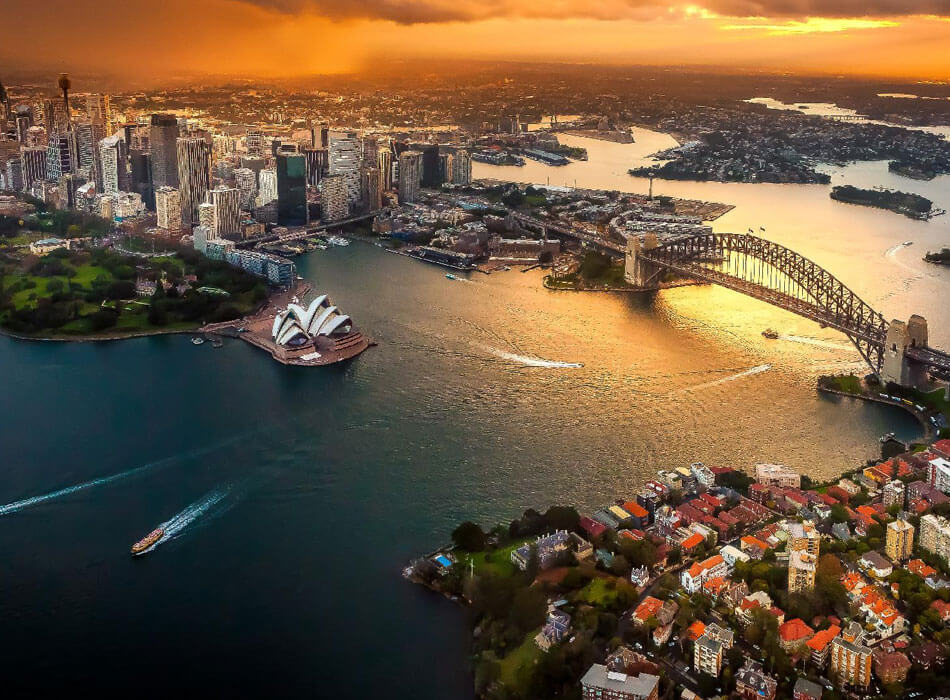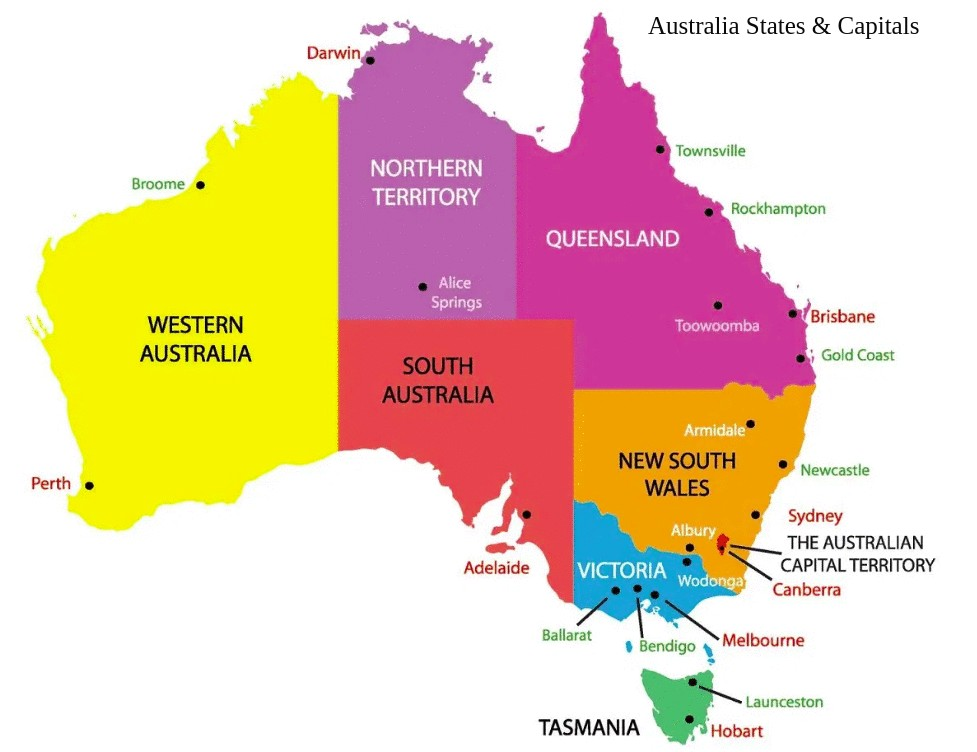Hotline: 0961.653.368 | 0928.693.368
Australia Overview
Australia is the smallest continent and one of the largest countries on Earth, lying between the Pacific and Indian oceans in the Southern Hemisphere. Its capital city is Canberra, and its most important economic and cultural centers are Sydney and Melbourne.
Australia has been called “the Oldest Continent,” “the Last of Lands,” and “the Last Frontier.” Those descriptions typify the world’s fascination with Australia, but they are somewhat unsatisfactory.

Physical geography
Australia is a country and an island located in Oceania between the Indian Ocean and the South Pacific Ocean. It shares its name with the country that claims control over it. Properly called the Commonwealth of Australia, its territory consists of the entire continent and smaller outlying islands. This makes it the sixth-largest country in the world by area of jurisdiction, which comprises 7,686,850 km2 (2,967,910 sq mi) (including Lord Howe Island and Macquarie Island), which is slightly smaller than the 48 states of the contiguous United States and 31.5 times larger than that of the United Kingdom.
The Australian mainland has a total coastline length of 35,821 km (22,258 mi) with an additional 23,860 km (14,830 mi) of island coastlines. There are 758 estuaries around the country with most located in the tropical and sub-tropical zones. A recent global remote sensing analysis suggested that there was 8,866 km2 (3,423 sq mi) of tidal flat area in Australia, making it the third-ranked country in terms of how much tidal flat occurs there. Australia has the third-largest exclusive economic zone of 8,148,250 km2 (3,146,060 sq mi)
Climate of Australia
Australia’s climate is governed mostly by its size and by the hot, sinking air of the subtropical high-pressure belt (subtropical ridge or Australian High).
Australia, a huge country of more than 7.5 million square kilometers (3 million square miles), crossed by the Tropic of Capricorn, has an arid climate, desert or semi-desert, in the vast central and western area, which is sparsely populated. In the far north (see Darwin), the climate is tropical with a dry and a rainy season.
Consequently, Australia’s winter is relatively mild, with less contrast between summer and winter temperatures than in the northern continents–though the transition is more dramatically marked in alpine regions of Australia and places of substantial elevation.
Capital city of states and territories of Australia
There are eight capital cities in Australia, Canberra is the capital city of Australia.
Australia is divided into six states (New South Wales, Queensland, South Australia, Tasmania, Victoria, and Western Australia), three internal territories (the Australian Capital Territory, the Jervis Bay Territory, and the Northern Territory), and seven external territories (Ashmore and Cartier Islands, the Australian Antarctic Territory, Christmas Island, the Cocos (Keeling) Islands, the Coral Sea Islands, Heard Island and McDonald Islands, and Norfolk Island).

| State / Territory | ISO Code | Type | Capital | Population (2020) | Area (sq km) |
|---|---|---|---|---|---|
| New South Wales | AU-NSW | State | Sydney | 8,157,735 | 809,952 |
| Queensland | AU-QLD | State | Brisbane | 5,160,023 | 1,851,736 |
| South Australia | AU-SA | State | Adelaide | 1,767,247 | 1,044,353 |
| Tasmania | AU-TAS | State | Hobart | 539,590 | 90,758 |
| Victoria | AU-VIC | State | Melbourne | 6,689,377 | 237,657 |
| Western Australia | AU-WA | State | Perth | 2,656,156 | 2,642,753 |
| Australian Capital Territory | ACT | Territory | Canberra | 429,834 | 2,358 |
| Jervis Bay Territory | ACT | Territory | None (Jervis Bay Village) | 405 | 67 |
| Northern Territory | NT | Territory | Darwin | 245,353 | 1,419,630 |
| Ashmore and Cartier Islands | Ext. Territory | None | 0 | 199 | |
| Australian Antarctic Territory | AQ | Ext. Territory | None (Davis Station) | 60 | 5,896,500 |
| Christmas Island | CX | Ext. Territory | Flying Fish Cove | 1,938 | 135 |
| Cocos (Keeling) Islands | CC | Ext. Territory | West Island | 547 | 14 |
| Coral Sea Islands | Ext. Territory | None (Willis Island) | 4 | 780,000 | |
| Heard Island and McDonald Islands | HM | Ext. Territory | None (Atlas Cove) | 0 | 372 |
| Norfolk Island | NF | Ext. Territory | Kingston | 1,758 | 35 |
Politics and Economy of Australia
Australia is a highly developed country with a mixed economy. As of 2023, Australia was the 14th-largest national economy by nominal GDP (gross domestic product), the 19th-largest by PPP-adjusted GDP, and was the 21st-largest goods exporter and 24th-largest goods importer. Australia took the record for the longest run of uninterrupted GDP growth in the developed world with the March 2017 financial quarter. It was the 103rd quarter and the 26th year since the country had a technical recession (two consecutive quarters of negative growth). As of June 2021, the country’s GDP was estimated at $1.98 trillion.
Australia is a federal parliamentary constitutional monarchy. The country has maintained a stable liberal democratic political system under its Constitution, the world’s tenth oldest, since Federation in 1901. Australia is the world’s sixth oldest continuous democracy and largely operates as a two-party system in which voting is compulsory.
Transportation of Australia
Australia offers comprehensive modes of transportation, ranging from trains, bicycles, buses, taxis to planes. Australia is highly dependent on road transport. There are more than 300 airports with paved runways.
Australian roads contribute the highest to the transportation sector of Australia, covering almost 913,000 kilometers of land area.
The large rail network in Australia comprises of more than 33,919 km of tracks. It is one of the easiest and convenient modes of transport in the country.
Another reason for the reliance upon roads is that the Australian rail network has not been sufficiently developed for a lot of the freight and passenger requirements in most areas of Australia.
Culture of Australia
The culture of Australia is primarily a Western culture, originally derived from Britain but also influenced by the unique geography of Australia and the cultural input of Aboriginal, Torres Strait Islander and other Australian people.
Australia’s culture is shaped by its diverse and ancient Indigenous heritage and its colonial history. Australian literature, music, and art reflect the country’s multicultural and regional influences, as well as its unique landscapes and wildlife.
Australians celebrate their culture through various events, such as Australia Day, Anzac Day, NAIDOC Week, and the Sydney Festival



